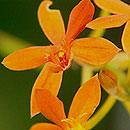Many plants are associated with Easter and the passion of Jesus Christ, although nobody really knows what sort of wood the cross was made of, or what plant was used to make the crown of thorns.
In our segment Peter Valder looked at two South American plants that were given religious significance by the Christian missionaries.
Crucifix orchid (Epidendrum ibaguense)
This species occurs naturally from Mexico to Colombia. It has long, thin stems and leathery leaves. The flowers bloom in clusters, with up to 20 flowers open on a stem at once. They come in orange, red, mauve, purple, salmon and yellow.
The common name ‘crucifix orchid’ refers to the lip of the flower (called the labellum), which resembles a small, gold cross. Crucifix orchids are tough, easy to grow, easily propagated and they have vivid, long lasting flowers. In fact, they are an excellent beginner’s orchid. They can be grown in containers in a free-draining mix, amongst rocks in the garden, or in soil. They like a frost-free climate and flower best in a full sun position.
Scarlet passion flower (Passiflora coccinea)
This strong growing, evergreen climber has dark green, crinkly leaves and beautiful, scarlet red flowers. The passion flower is the ultimate symbol of the crucifixion. The stigma (female part of the flower) is divided into three and resembles three nails. The five stamens (male part of the flower) are said to represent the five wounds Jesus received, one in each hand and foot and one in the side. The corona, a structure at the base just above the petals, represents the crown of thorns. The ten red petals represent the ten disciples (Peter, who denied Jesus, and Judas, who betrayed him, are omitted). The leaves and tendrils of the vine represent the hands and whips that scourged Jesus.
P. coccinea is grown for its large, vivid red flowers, rather than for its fruit. Plants can have flowers for much of the year but are seen at their peak in summer and autumn. It grows best in the warmer areas of Australia, and needs protection from frost when young.
All passionfruit like a well-drained soil enriched with organic matter, such as well-rotted manure or compost. They need a warm sunny position – a north to northwesterly aspect against a masonry wall would be necessary in cooler zones. Water deeply at least once a week during warm weather and keep well mulched. Fertilise in spring with a slow release fertiliser, add well-rotted manure to the mulch and spread it around the root system.
Getting started
Crucifix orchids are available at nurseries, specialist orchid nurseries or by mail order. Prices range from about $3.50 to $25 depending on the variety.
Red passionfruit is hard to find, but your local nursery should be able to order one in for you. Expect to pay around $20 for a plant in a 200mm (8″) pot.
Further information
Our story was filmed at:
House of Phalaenopsis
Lane Cove, NSW 2066
Phone: (02) 9427 3659



